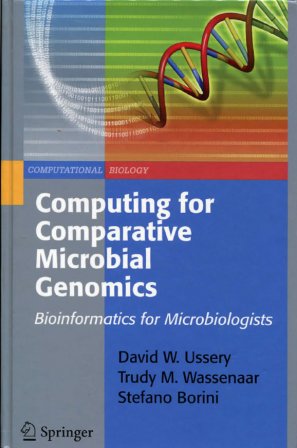 Bioinformatics for Microbiologists, by D.W. Ussery, T.M. Wassenaar and S. Borini is part of the series Computing for Comparative Microbial Genomics. The book is written for microbiologists needing an introduction to genomics as well as for bioinformaticists who need to be introduced to microbiology. First, a brief overview of molecular biology and of the concept of sequences as biological information are given. There are four main parts: Introduction, Comparative Genomics, Transcriptomics and Proteomics, and Microbial Communities.
Bioinformatics for Microbiologists, by D.W. Ussery, T.M. Wassenaar and S. Borini is part of the series Computing for Comparative Microbial Genomics. The book is written for microbiologists needing an introduction to genomics as well as for bioinformaticists who need to be introduced to microbiology. First, a brief overview of molecular biology and of the concept of sequences as biological information are given. There are four main parts: Introduction, Comparative Genomics, Transcriptomics and Proteomics, and Microbial Communities.
"It is a very well-written review of genomics and proteomics of microbes, and makes convincing arguments for the practicality of applying bioinformatics to the study of communities of these species. The references are well chosen. The writing style is superb. … There is an amazing amount of interesting material… The book is probably more suitable as an introduction to contemporary applications of bioinformatics and microbiology for computational scientists."
(Anthony J. Duben, ACM Computing Reviews, June, 2009)“
ISBN: 978-1848002548
Hardcover, 274 pages
Publisher: Springer
First published: February 2009
Bioinformatics for Microbiologists is available as Hardcover, paperback and Ebook
A peek inside the book:
Chapter 14: Evolution of microbial communities; or, On the origin of bacterial species.
Outline. Evolution can be thought of as the adaptation or optimization of species to their environment. Since, at the level of microorganisms, there can be considerable differences in microenvironments, it is not hard to imagine that many bacteria have a constant need to be adaptable and ready to change to new surroundings. In this final chapter, we will take a look at the processes that drive evolution, and at the evolutionary traces that are visible in the DNA sequences of genomes. Mobile DNA elements play an important role in evolution and an example is given for insertion sequences in Shigella flexneri. Genome islands can be considered genetic ‘building blocks’ that can be added to, or removed from a genome core. Finally we will take a closer look at Vibrio cholerae, how this species differs from other Vibrio species, and how a relatively small set of genes can be responsible for niche adaptation (and sometimes speciation). The amount of genomic diversity within closely related bacterial populations is far greater than anyone had imagined, and the raw material for evolution is abundant in the microbial world.

